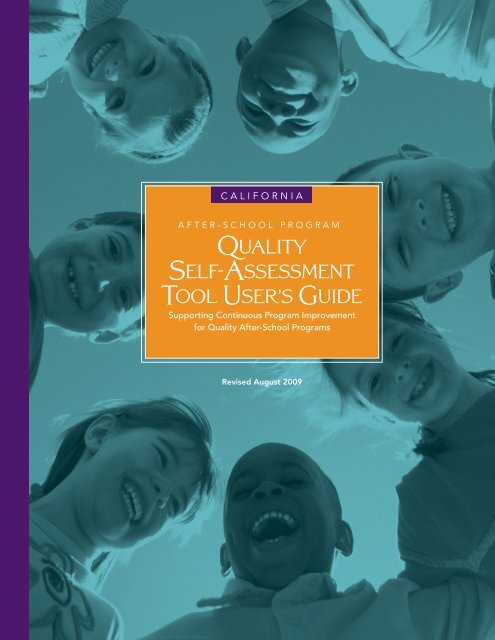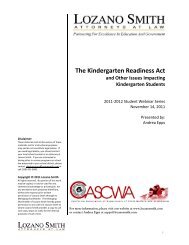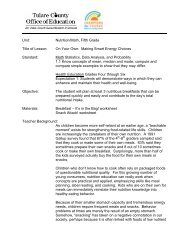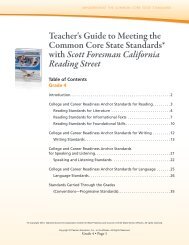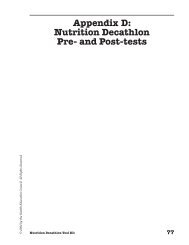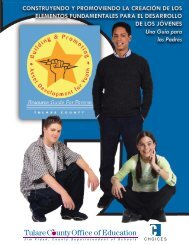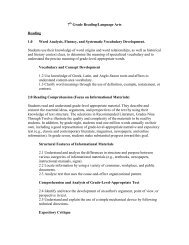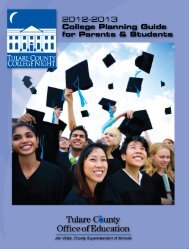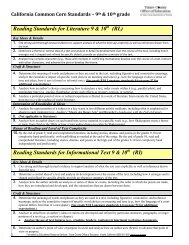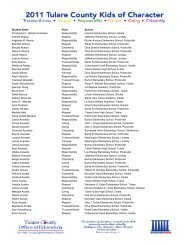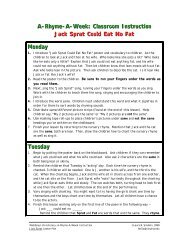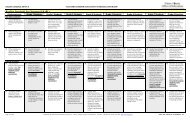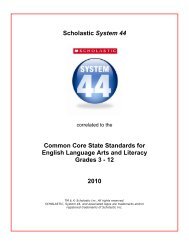Quality Self-Assessment Tool User's Guide - The Power of Discovery
Quality Self-Assessment Tool User's Guide - The Power of Discovery
Quality Self-Assessment Tool User's Guide - The Power of Discovery
Create successful ePaper yourself
Turn your PDF publications into a flip-book with our unique Google optimized e-Paper software.
C A L I F O R N I A<br />
A F T E R - S C H O O L P R O G R A M<br />
<strong>Quality</strong><br />
<strong>Self</strong>-<strong>Assessment</strong><br />
<strong>Tool</strong> User’s <strong>Guide</strong><br />
Supporting Continuous Program Improvement<br />
for <strong>Quality</strong> After-School Programs<br />
Revised August 2009
D E V E L O P E D I N C O L L A B O R AT I O N B Y:<br />
<strong>The</strong> California Afterschool Network<br />
<strong>Quality</strong> Committee<br />
University <strong>of</strong> California at Davis<br />
School <strong>of</strong> Education<br />
One Shields Ave, TB. 206<br />
Davis, CA 95616<br />
(530) 752-5965<br />
www.afterschoolnetwork.org<br />
A N D<br />
After School Programs Office<br />
California Department <strong>of</strong> Education<br />
1430 N Street, Suite 6408<br />
Sacramento, CA 95814-5901<br />
(916) 319-0923<br />
www.cde.ca.gov/ls/ba
C A L I F O R N I A<br />
A F T E R - S C H O O L P R O G R A M<br />
<strong>Quality</strong> <strong>Self</strong>-<strong>Assessment</strong> <strong>Tool</strong><br />
User’s <strong>Guide</strong><br />
TA B L E O F C O N T E N T S<br />
I. Acknowledgments . . . . . . . . . . . . . . . . . . . . . . . . . . . . . . . . . . . . . . . . . . 2<br />
II. <strong>The</strong> California After-School <strong>Quality</strong> <strong>Self</strong>-<strong>Assessment</strong> <strong>Tool</strong><br />
Starts Important Conversations about Program <strong>Quality</strong> . . . . . . . . . . . . 3<br />
III. Overview Of <strong>The</strong> <strong>Quality</strong> <strong>Self</strong>-<strong>Assessment</strong> <strong>Tool</strong> . . . . . . . . . . . . . . . . . . . 4<br />
IV. Using the <strong>Quality</strong> <strong>Self</strong>-<strong>Assessment</strong> <strong>Tool</strong> . . . . . . . . . . . . . . . . . . . . . . . . . 6<br />
Quick <strong>Guide</strong>. . . . . . . . . . . . . . . . . . . . . . . . . . . . . . . . . . . . . . . . . . . . . . . . 6<br />
Survey-to-Discussion Method.. . . . . . . . . . . . . . . . . . . . . . . . . . . . . . . . . . 8<br />
Consensus-Based Discussion Method.. . . . . . . . . . . . . . . . . . . . . . . . . . . 10<br />
Suggested Stakeholders by Program <strong>Quality</strong> Element.. . . . . . . . . . . . . . 13<br />
V. Planning for Program Improvement<br />
Action Plan <strong>Guide</strong>.. . . . . . . . . . . . . . . . . . . . . . . . . . . . . . . . . . . . . . . . . . 14<br />
Issue Diagnosis <strong>Guide</strong>—Program <strong>Quality</strong><br />
Elements to Sustain.. . . . . . . . . . . . . . . . . . . . . . . . . . . . . . . . . . . . . . . 16<br />
Issue Diagnosis <strong>Guide</strong>—Program <strong>Quality</strong><br />
Elements to Improve.. . . . . . . . . . . . . . . . . . . . . . . . . . . . . . . . . . . . . . 17<br />
After School Program Training & Technical<br />
Assistance Request <strong>Guide</strong>.. . . . . . . . . . . . . . . . . . . . . . . . . . . . . . . . . . 20<br />
After School Program Training & Technical<br />
Assistance Request .. . . . . . . . . . . . . . . . . . . . . . . . . . . . . . . . . . . . . . . 21<br />
Action Plan Follow-up <strong>Guide</strong>. . . . . . . . . . . . . . . . . . . . . . . . . . . . . . . . . . 22<br />
VI. Source Documents . . . . . . . . . . . . . . . . . . . . . . . . . . . . . . . . . . . . . . . . . 23<br />
C A L I F O R N I A A F T E R - S C H O O L P R O G R A M Q U A L I T Y S E L F - A S S E S S M E N T T O O L<br />
1
I<br />
ACKNOWLEDGMENTS<br />
<strong>The</strong> California After School Program <strong>Quality</strong> <strong>Self</strong>-<strong>Assessment</strong> <strong>Tool</strong> is a collaborative project<br />
<strong>of</strong> the California Afterschool Network and the California Department <strong>of</strong> Education<br />
(CDE). Network Staff engaged the CDE, Regional Leads, <strong>The</strong> California After School<br />
Demonstration Program (CASDP), <strong>The</strong> California After School Inclusion Project,<br />
California Tomorrow, <strong>The</strong> Alliance for a Better Community, <strong>The</strong> Center for Afterschool<br />
Education, <strong>The</strong> Network <strong>Quality</strong> Committee, <strong>The</strong> Network Nutrition and Physical<br />
Activity Committee, ASAP Connect, after school providers, QSA <strong>Tool</strong> Implementation<br />
Pilot Sites, and national experts in the revision <strong>of</strong> the <strong>Tool</strong>.<br />
SPECIAL THANKS TO<br />
THE CO-CHAIRS OF THE<br />
CASN QUALITY COMMITTEE<br />
Katie Brackenridge<br />
Bay Area Partnership<br />
Marcella Klein-Williams<br />
Ventura County Office <strong>of</strong> Education<br />
THE COMMITTEE’S<br />
FORMER CO-CHAIRS<br />
Lindsay Callahan<br />
Central Valley Afterschool Foundation<br />
Amy Scharf<br />
California Tomorrow<br />
THANKS ALSO TO<br />
in alphabetical order<br />
Jhumpa Bhattachyara<br />
California Tomorrow<br />
Kim Boyer<br />
Central Valley Afterschool Foundation<br />
Andrea Bustamante<br />
San Francisco Unified School District ExCEL<br />
After School Programs<br />
Regino Chavez<br />
LA’s BEST<br />
Cheri Chord<br />
Sacramento START<br />
Amy Christianson<br />
Butte County Office <strong>of</strong> Education<br />
Sue Eldredge<br />
Community Network for Youth<br />
Development<br />
Yvonne Evans<br />
California Department <strong>of</strong> Education<br />
Valodie Foster<br />
California Department <strong>of</strong> Education<br />
Kica Gazmuri<br />
CalSAC<br />
Robert Granger<br />
William T. Grant Foundation<br />
Gloria Halley<br />
Butte County Office <strong>of</strong> Education<br />
Nora Hannah<br />
San Joaquin County Office <strong>of</strong> Education<br />
Doreen Hassan<br />
YMCA <strong>of</strong> Silicon Valley<br />
Arnell Hinkle<br />
CANFit<br />
KJ Lavoie<br />
Boys and Girls Clubs <strong>of</strong> America<br />
Kathy Lewis<br />
Center for Collaborative Solutions<br />
Helen Magnusun<br />
California Department <strong>of</strong> Public Health<br />
John Malloy<br />
California Department <strong>of</strong> Education<br />
Mariah Martin<br />
California After School Resource Center<br />
Debra Mason<br />
Mt. Diablo CARES<br />
Norma Munroe<br />
California Department <strong>of</strong> Education<br />
Renee Mora<br />
Teague KIDS After-School Program<br />
Corey Newhouse<br />
Public Pr<strong>of</strong>it<br />
Laurie Olsen<br />
California Tomorrow<br />
Michelle Perrenoud<br />
Los Angeles County Office <strong>of</strong> Education<br />
Sam Piha<br />
Temescal Associates<br />
Jimena Quiroga<br />
California Tomorrow<br />
Chris Rury<br />
California Department <strong>of</strong> Education<br />
Monica Santos<br />
Team Up For Youth<br />
Kathie Scott<br />
California Department <strong>of</strong> Education<br />
Charles Smith<br />
David P. Weikart Center for<br />
Youth Program <strong>Quality</strong><br />
Deborah Tamannaie<br />
California Department <strong>of</strong> Education<br />
Claudia Weisburd<br />
Center for Afterschool Education<br />
Nicole Yohalem<br />
<strong>The</strong> Forum for Youth Investment<br />
Cynthia V. Zarate<br />
Alliance for a Better Community.<br />
WE ARE GRATEFUL FOR THE TIME<br />
AND ATTENTION THAT OUR PILOT<br />
PROGRAMS GAVE TO THE QSA<br />
TOOL TESTING PROCESS:<br />
w <strong>The</strong> Community Network for Youth<br />
Development—Program <strong>Quality</strong><br />
Learning Network<br />
w Galt High School District<br />
w Long Beach YMCA<br />
w San Francisco ExCEL<br />
CALIFORNIA AFTERSCHOOL NET-<br />
WORK STAFF, 2008-09<br />
Andee Press-Dawson<br />
Executive Director<br />
Jeff Davis<br />
Program Coordinator<br />
John Jones<br />
Web Developer<br />
Joanne Bookmyer<br />
Research Associate<br />
2 C A L I F O R N I A A F T E R - S C H O O L P R O G R A M Q U A L I T Y S E L F - A S S E S S M E N T T O O L
II<br />
THE CALIFORNIA QUALITY SELF-ASSESSMENT<br />
TOOL STARTS IMPORTANT CONVERSATIONS<br />
ABOUT PROGRAM QUALITY<br />
Today in California, thousands <strong>of</strong> after-school programs <strong>of</strong>fer students hands-on opportunities<br />
to explore their talents and interests, to succeed in school, and to give back<br />
to their communities. <strong>The</strong>se programs provide thousands <strong>of</strong> youth—from kindergarten<br />
through high school—with safe, enriching environments in the after school hours.<br />
To ensure that the young people we serve thrive and succeed, we need well designed,<br />
properly equipped and maintained after school programs. <strong>The</strong>se programs <strong>of</strong>fer a diverse<br />
range <strong>of</strong> high quality, relevant and engaging activities that link to the school day. <strong>The</strong><br />
diversity <strong>of</strong> California’s youth also requires proactively inclusive, accessible and culturally<br />
competent after school programs.<br />
<strong>The</strong> California After School Program <strong>Quality</strong> <strong>Self</strong>-<strong>Assessment</strong> (QSA) <strong>Tool</strong> provides after<br />
school programs with a clear and concise way to start important conversations about<br />
program quality. <strong>The</strong> QSA <strong>Tool</strong> facilitates program improvement and support through a<br />
staff-directed process, rather than through external monitoring.<br />
RESEARCH SHOWS THAT HIGH QUALITY AFTER SCHOOL PROGRAMS:<br />
w Have clearly defined and measurable goals that address community-specific interests<br />
and needs.<br />
w Implement program activities to achieve specific program goals.<br />
w Incorporate youth development policies and practices throughout the program.<br />
w Use many kinds <strong>of</strong> data to assess their progress.<br />
THE QSA TOOL CAN BE USED TO:<br />
w Engage key stakeholders (i.e., program/site staff, program administration,<br />
school teachers and administrators, collaborators) in meaningful<br />
conversations about program quality and continuous program improvement.<br />
w Encourage after school program stakeholders to think about ways in<br />
which they can support high quality after school programming in their<br />
community.<br />
w Generate an action plan that identifies the immediate, mid-range, and<br />
long-term pr<strong>of</strong>essional development and technical support needed to<br />
enhance program quality.<br />
<strong>The</strong> QSA <strong>Tool</strong> is meant to support a reflective process in which program<br />
staff and stakeholders explore their own programs and work collaboratively<br />
to develop strategies to enhance policies, procedures and practices.<br />
<strong>The</strong> QSA <strong>Tool</strong> will help program staff and stakeholders assess their program<br />
and identify their challenges. As a result, the QSA <strong>Tool</strong> is appropriate<br />
for formative assessments and for building teams that will work toward<br />
program improvement. <strong>The</strong> QSA <strong>Tool</strong> should not be used as an external<br />
evaluation measure.<br />
C A L I F O R N I A A F T E R - S C H O O L P R O G R A M Q U A L I T Y S E L F - A S S E S S M E N T T O O L<br />
3
III<br />
WHAT’S INSIDE THE QSA TOOL: ELEVEN QUALITY ELEMENTS<br />
<strong>The</strong> QSA <strong>Tool</strong> is organized into eleven quality elements identified through review <strong>of</strong> current<br />
after school literature and research.<br />
<strong>Quality</strong> Element<br />
Section 1: Program Design & <strong>Assessment</strong><br />
Section 2: Program Administration & Finance<br />
Section 3: Community Partnerships & Collaboration<br />
Section 4: Alignment & Linkages with the School Day<br />
Section 5: Program Environment & Safety<br />
Section 6: Youth Development<br />
Section 7: Staff Recruitment & Pr<strong>of</strong>essional Development<br />
Section 8: Family Involvement<br />
OVERVIEW OF THE PROGRAM<br />
SELF-ASSESSMENT TOOL<br />
Section 9: Nutrition & Physical Activity<br />
Section 10: Promoting Diversity, Access, Equity, & Inclusion<br />
Section 11: Effectively Supporting English Learners<br />
PERFORMANCE LEVELS<br />
<strong>The</strong> QSA <strong>Tool</strong> uses the following rating system to assess the degree to which each quality<br />
indicator is evident in the program<br />
Level 1: Our program is just beginning to work in this area and has an urgent need to<br />
address this practice. Our program can be much better at this than we are currently.<br />
Level 2: Our program has done some work in this area but will need targeted support<br />
to move to the next level. Our program is making progress, but can improve<br />
further.<br />
Level 3: Our program has achieved a high level <strong>of</strong> pr<strong>of</strong>iciency in this area and needs<br />
only a little additional work to be exceptionally pr<strong>of</strong>icient. Our program is very<br />
good at this practice.<br />
Level 4: Our program is exceptionally pr<strong>of</strong>icient in this practice and can demonstrate<br />
this in observable ways. This is an area <strong>of</strong> quality practice where our program<br />
can serve as an example for others.<br />
Don’t Know: I am not familiar enough with this aspect <strong>of</strong> the program to rate performance<br />
on this indicator or am just not sure how to rate it at this time.<br />
After school programs should strive to meet Level 3 or 4 for each indicator to demonstrate<br />
overall program quality. Assistance and support should be sought for areas scoring<br />
as Level 1 or Level 2.<br />
<strong>The</strong>re is space next to each indicator for respondents to note what the practice looks like<br />
at their site or in their organization. This can help to inform the team’s discussion <strong>of</strong> the<br />
results.<br />
4 C A L I F O R N I A A F T E R - S C H O O L P R O G R A M Q U A L I T Y S E L F - A S S E S S M E N T T O O L
USING THE QSA TOOL FOR PROGRAM PLANNING &<br />
PROFESSIONAL DEVELOPMENT<br />
When developing an action plan based on the QSA <strong>Tool</strong> ratings, after school programs<br />
should consider the following:<br />
w What is the current Performance Level in our program? Practices that receive a<br />
1 or 2 rating will likely need to be addressed in the short-term. Practices that receive a<br />
3 rating will likely need additional attention within the current school/fiscal year, and<br />
practices that are rated as a 4 should be sustained.<br />
w How urgent is the need to address the practice? Practices that have a direct<br />
impact on participants’ health and safety or that are closely linked to program goals<br />
should take priority in the action plan.<br />
Each High program quality quality state-funded element includes after-school a section programs at the end cannot to record overlook thoughts grant about<br />
planned compliance next steps requirements. and technical assistance For more needs. information, <strong>The</strong> User’s visit <strong>Guide</strong> the includes California suggestions<br />
for programs Department to develop <strong>of</strong> Education an action After plan based School on results Programs <strong>of</strong> the Office self-assessment. web site at<br />
www.cde.ca.gov/ls/ba<br />
C A L I F O R N I A A F T E R - S C H O O L P R O G R A M Q U A L I T Y S E L F - A S S E S S M E N T T O O L<br />
5
IV<br />
USING THE PROGRAM QUALITY<br />
SELF-ASSESSMENT TOOL<br />
QUICK GUIDE<br />
After school programs must decide how best to use the QSA <strong>Tool</strong>. <strong>The</strong>re is no<br />
one right way to use it! Use the following steps to determine how your program can<br />
use the QSA <strong>Tool</strong> to assess program quality and develop an action plan.<br />
STEP ONE: SELECT QUALITY ELEMENTS AND<br />
FORM A SELF-ASSESSMENT TEAM<br />
To get ready to complete the QSA <strong>Tool</strong> for your program or organizations, think about<br />
the following:<br />
Which quality elements should we consider?<br />
<strong>The</strong> QSA <strong>Tool</strong> includes 11 quality elements. Depending on the time and resources available,<br />
programs may choose to complete the entire QSA <strong>Tool</strong> at one time, or to consider a<br />
few quality elements in turn.<br />
Programs should allow sufficient time to train staff and stakeholders in the use <strong>of</strong> the<br />
<strong>Tool</strong>, to review feedback about each program quality element, and to develop an<br />
action plan.<br />
Who should participate in the self-assessment?<br />
After school programs can have many stakeholders, ranging from program staff and administrators,<br />
to students and parents, to principals and teachers. Depending on the local<br />
context, programs may choose to invite a variety <strong>of</strong> stakeholders to participate.<br />
Depending on who is asked to participate in the self-assessment process, programs may<br />
need to collect input in a variety <strong>of</strong> ways. For example, participants can provide input<br />
into program quality through brief surveys or focus groups, parents and caregivers can<br />
provide feedback through informal conversations, community meetings, or surveys in<br />
their primary language.<br />
Many Stakeholders Can Provide Input Into <strong>Quality</strong> <strong>Self</strong>-<strong>Assessment</strong><br />
Parents*<br />
Youth*<br />
Program<br />
Managers &<br />
Administrators<br />
Youth<br />
Workers<br />
Program<br />
<strong>Quality</strong><br />
Principals &<br />
Teachers<br />
Community<br />
Partners<br />
*Parent and youth feedback can come from informal conversations, focus groups, or<br />
surveys that explore similar themes as the QSA <strong>Tool</strong>.<br />
6 C A L I F O R N I A A F T E R - S C H O O L P R O G R A M Q U A L I T Y S E L F - A S S E S S M E N T T O O L
STEP TWO: COLLECT INPUT<br />
<strong>The</strong>re are a wide variety <strong>of</strong> ways to use the QSA <strong>Tool</strong> to collect input about program<br />
quality, after school programs should use the <strong>Tool</strong> in a way that works for them.<br />
Examples include:<br />
w Using the QSA <strong>Tool</strong> as a start-<strong>of</strong>-year and end-<strong>of</strong>-year assessment that charts changes<br />
in program quality over time.<br />
w Using the QSA <strong>Tool</strong> as a guide for staff development, walking staff members through<br />
each element and discussing their role in supporting program quality.<br />
w Completing the QSA <strong>Tool</strong> as a survey and meeting to review the results<br />
(See Survey-to-Discussion <strong>Guide</strong>).<br />
w Meeting in small groups to review program quality elements and develop consensusbased<br />
ratings (See Consensus-Based Discussion <strong>Guide</strong>).<br />
It is critical to set the stage for the self-assessment team, so that team members understand<br />
the purpose <strong>of</strong> the process. Consider:<br />
w Do staff and stakeholders understand the purpose <strong>of</strong> self-assessment?<br />
<strong>Self</strong>-assessment is not a requirement or evaluation, but instead a way to stimulate<br />
important conversations about program quality.<br />
w Are stakeholders asked to provide input in a way that works for them?<br />
Program staff may prefer to complete the QSA <strong>Tool</strong> anonymously; youth could provide<br />
feedback through a focus group.<br />
w Have stakeholders reviewed the quality elements and asked<br />
clarifying questions?<br />
Depending on their familiarity with specific program quality elements, members <strong>of</strong><br />
the self-assessment team may need additional clarity before providing input.<br />
STEP THREE: ACTION PLANNING<br />
Based on the team’s assessment findings, the self-assessment team (or subcommittee)<br />
will develop an action plan to improve practice quality where needed and to sustain their<br />
strengths. See the Action Plan <strong>Guide</strong> on page 14 for more details on this step.<br />
To carry out its action plan, a program may require technical assistance and other<br />
supportive resources. <strong>The</strong> After School Program <strong>Self</strong>-<strong>Assessment</strong> Summary and Assistance<br />
Request form on page 20 is one way to request this type <strong>of</strong> assistance.<br />
Additional resources about after school program quality are located at the California Afterschool<br />
Network’s web site at www.afterschoolnetwork.org/quality-improvement.<br />
STEP FOUR: FOLLOW UP<br />
Reflecting on the steps that your program has taken to improve will deepen the assessment<br />
team’s experience and promote a healthy sense <strong>of</strong> joint responsibility for program<br />
quality. At the conclusion <strong>of</strong> the school year—or at least three months after the implementation<br />
<strong>of</strong> the action plan—program staff should spend about an hour sharing the<br />
activities they have undertaken to address quality, what’s worked and what hasn’t, and<br />
what remains to be done in the future. This step is detailed in the Action Plan Follow-Up<br />
<strong>Guide</strong> on page 22.<br />
C A L I F O R N I A A F T E R - S C H O O L P R O G R A M Q U A L I T Y S E L F - A S S E S S M E N T T O O L<br />
7
SURVEY-TO-DISCUSSION METHOD<br />
This section describes one potential way for programs to use the QSA <strong>Tool</strong> to start<br />
important conversations about program quality. Other examples are provided in the<br />
Consensus-Based Scoring <strong>Guide</strong> and Section IV.<br />
<strong>The</strong> Survey-to-Discussion method is most effective for large after school programs or<br />
multi-site projects with many self-assessment team members and limited group discussion<br />
time.<br />
AT-A-GLANCE<br />
Get Ready,<br />
Get Set<br />
• Form a self-assessment team<br />
• Prep materials<br />
• Orientation<br />
Collect Input<br />
on <strong>Quality</strong><br />
• Complete survey<br />
• Consolidate data<br />
Review the<br />
Results<br />
• Strengths<br />
• Areas to improve<br />
Complete an<br />
Action Plan<br />
• Sustaining strengths<br />
• Targets for improvement<br />
GET READY, GET SET…<br />
1. Form a <strong>Self</strong>-<strong>Assessment</strong> Team—Invite a variety <strong>of</strong> stakeholders to participate in<br />
order to include multiple points <strong>of</strong> view; schedule sufficient time to review the <strong>Tool</strong>,<br />
collect responses, discuss the results, and develop an action plan.<br />
2. Prepare Necessary Materials—Provide a copy <strong>of</strong> the QSA <strong>Tool</strong> for each team<br />
member and identify a tabulation method (tools are available at www.afterschoolnetwork.org/qsatool).<br />
3. Orient the Team—Meet in advance to explain the purpose <strong>of</strong> self-assessment, to<br />
review the QSA <strong>Tool</strong>, and to explain how the results will be tabulated and used.<br />
COLLECT INPUT ON QUALITY<br />
1. Complete the QSA—Each self-assessment team member will complete the QSA<br />
<strong>Tool</strong> on their own.<br />
2. Summarize individual responses—Depending on how programs are using the QSA<br />
<strong>Tool</strong>, they may choose to summarize input for individual programs or a group <strong>of</strong> sites.<br />
8 C A L I F O R N I A A F T E R - S C H O O L P R O G R A M Q U A L I T Y S E L F - A S S E S S M E N T T O O L
REVIEW THE RESULTS<br />
1. Warming Up—Prior to reviewing the self-assessment results, allow team members<br />
a few minutes to discuss the program content areas (or specific indicators/practices)<br />
that they anticipate being the strongest or weakest, and the examples they use to support<br />
their conclusion.<br />
Asking team members for their input will enhance their engagement in the discussion<br />
and will emphasize that survey results aren’t the only valid source <strong>of</strong> information<br />
about program quality. <strong>The</strong>se other ways <strong>of</strong> knowing are critical additional sources <strong>of</strong><br />
information that will assist in understanding the survey results.<br />
Facilitator note: In some cases, you may need to encourage team members to provide concrete<br />
and objective evidence, rather than opinions. So, for example, it is less helpful to predict<br />
that a program will score poorly on a particular element because “our program administration<br />
is not supportive” than to identify the resource, training, and practice deficiencies that<br />
affect a particular element.<br />
2. Discussing the Results—Depending on the number <strong>of</strong> program quality elements<br />
assessed by the team, this phase <strong>of</strong> self-assessment may include discussing individual<br />
elements or comparing results across multiple elements.<br />
REFLECTING ON A SPECIFIC QUALITY ELEMENT FOR EACH<br />
PROGRAM QUALITY ELEMENT, DISCUSS:<br />
w Which indicators are rated the highest? What does our program do to<br />
accomplish this?<br />
w Which indicators are rated the lowest? What does our program currently<br />
do (or not do) that affects this practice?<br />
w Are there any indicators whose ratings are much higher or lower than<br />
predicted? Why might that be?<br />
w Are there any indicators for which many people said they didn’t know<br />
the answer? Does this suggest the need for additional information,<br />
training, or resources?<br />
COMPARING MULTIPLE QUALITY ELEMENTS WHEN COMPARING<br />
RATINGS FOR MULTIPLE QUALITY ELEMENTS, DISCUSS:<br />
w Which program quality elements (i.e. Program Design/<strong>Assessment</strong>,<br />
Youth Development) are strongest in this program? Why?<br />
w Which program quality elements received the lowest overall ratings?<br />
Why?<br />
w Does a high or low rating for one program quality element affect our<br />
performance on another? How? Does this suggest need for additional<br />
information, training, or resources?<br />
COMPLETE AN ACTION PLAN<br />
Based on the team’s assessment findings, the self-assessment team (or subcommittee)<br />
will develop an action plan to improve quality practice where needed and to maintain<br />
those areas in which programs are strongest. See the Action Plan <strong>Guide</strong> on page 14 for<br />
further details.<br />
C A L I F O R N I A A F T E R - S C H O O L P R O G R A M Q U A L I T Y S E L F - A S S E S S M E N T T O O L<br />
9
CONSENSUS-BASED DISCUSSION METHOD<br />
<strong>The</strong> Consensus-Based Discussion method is one potential way for programs to use the QSA <strong>Tool</strong><br />
to start important conversations about program quality. Other examples are provided in the<br />
Survey-to-Discussion <strong>Guide</strong> and Section IV.<br />
<strong>The</strong> Consensus-Based Discussion method is most effective for small groups <strong>of</strong> staff<br />
and stakeholders (e.g. at the site level) or programs with regularly scheduled, lengthy selfassessment<br />
team meetings.<br />
AT-A-GLANCE<br />
Get Ready,<br />
Get Set<br />
• Form a self-assessment team<br />
• Prep materials<br />
• Orientation<br />
Collect Input<br />
on <strong>Quality</strong><br />
• Identify expectations<br />
• Come to consensus<br />
about ratings<br />
Review the<br />
Results<br />
• Strengths<br />
• Areas to improve<br />
Complete an<br />
Action Plan<br />
• Sustaining strengths<br />
• Targets for improvement<br />
GET READY, GET SET…<br />
1. Form a <strong>Self</strong>-<strong>Assessment</strong> Team—Invite a variety <strong>of</strong> stakeholders to participate in<br />
order to include multiple points <strong>of</strong> view; schedule sufficient time to review the <strong>Tool</strong>,<br />
collect responses, discuss the results, and develop an action plan.<br />
2. Prepare Necessary Materials—Provide a copy <strong>of</strong> the QSA <strong>Tool</strong> for each team<br />
member and identify a tabulation method (tools are available at www.afterschoolnetwork.org/qsatool).<br />
3. Orient the Team—Meet in advance to explain the purpose <strong>of</strong> self-assessment, to<br />
review the QSA <strong>Tool</strong>, and to explain how the results will be tabulated and used.<br />
10 C A L I F O R N I A A F T E R - S C H O O L P R O G R A M Q U A L I T Y S E L F - A S S E S S M E N T T O O L
DISCUSS QUALITY PRACTICE<br />
1. Warming Up—Ask team members to briefly discuss the quality indicators where<br />
they expect there to be more disagreement and why. Review strategies for resolving<br />
disagreements on indicator ratings.<br />
RESOLVING DIFFERENCES OF OPINION IN<br />
CONSENSUS-BASED SCORING<br />
Ask the other person<br />
w What would the “perfect practice” look like for you?<br />
w How does our program measure up to your expectations, based on<br />
observable practices and policies?<br />
w How does the rating you chose (e.g. 3) align with the examples you<br />
gave?<br />
w Tell your teammate what you hear them saying to ensure that you are<br />
interpreting them correctly.<br />
Ask yourself<br />
w Is my teammate using a different definition <strong>of</strong> the practice than I am?<br />
w Does my teammate have additional information about our program?<br />
w Do we have a similar understanding <strong>of</strong> the rating scale?<br />
w How does this new input affect my opinion about the rating?<br />
2. Assessing the Program—How the team approaches this process will depend on<br />
how many team members participate. A small team (less than eight) can simply work<br />
its way through the QSA <strong>Tool</strong>, discussing with one another the rating that they would<br />
give to each quality indicator and why.<br />
A large assessment team might consider a two-step assessment process. First, groups<br />
<strong>of</strong> three to five team members review the indicators in one program content area<br />
at a time. To make this a more dynamic process, write each program content area<br />
(and its corresponding indicators) on chart paper and distribute them around the<br />
room. Small groups can then circulate around the room discussing the indicators in<br />
each program content area. Second, the small groups reconvene. <strong>The</strong> whole group<br />
discusses and compares indicator ratings and arrives at consensus.<br />
In most cases, the group will agree on a rating with minimal discussion. For some<br />
indicators, however, team members may suggest widely different ratings. In this case,<br />
the team (or those who initially disagree on the rating) should explore their divergent<br />
views, with the goal <strong>of</strong> agreeing on a single rating. As the group determines the scores,<br />
they should take notes on the conversation held, particularly for those indicators<br />
about which they disagreed. <strong>The</strong>se indicators may highlight areas in which a program<br />
needs to clarify expectations, enhance resources, and keep the team involved in discussion<br />
and planning.<br />
C A L I F O R N I A A F T E R - S C H O O L P R O G R A M Q U A L I T Y S E L F - A S S E S S M E N T T O O L<br />
11
REVIEW THE RESULTS<br />
Depending on the number <strong>of</strong> program quality elements assessed by the team, this phase<br />
<strong>of</strong> self-assessment may include discussing individual elements or comparing results<br />
across multiple elements.<br />
REFLECTING ON A SPECIFIC QUALITY ELEMENT FOR EACH<br />
PROGRAM QUALITY ELEMENT, DISCUSS:<br />
w Which indicators are rated the highest? What does our program do to<br />
accomplish this?<br />
w Which indicators are rated the lowest? What does our program currently<br />
do (or not do) that affects this practice?<br />
w Are there any indicators whose ratings are much higher or lower than<br />
predicted? Why might that be?<br />
w Are there any indicators for which many people said they didn’t know<br />
the answer? Does this suggest the need for additional information,<br />
training, or resources?<br />
COMPARING MULTIPLE QUALITY ELEMENTS WHEN COMPARING<br />
RATINGS FOR MULTIPLE QUALITY ELEMENTS, DISCUSS:<br />
w Which program quality elements (i.e. Program Design/<strong>Assessment</strong>,<br />
Youth Development) are strongest in this program? Why?<br />
w Which program quality elements received the lowest overall ratings?<br />
Why?<br />
w Does a high or low rating for one program quality element affect our<br />
performance on another? How? Does this suggest need for additional<br />
information, training, or resources?<br />
COMPLETE AN ACTION PLAN<br />
Based on the team’s assessment findings, team members (or a sub-committee) will<br />
develop an action plan to improve quality practice where needed and to maintain those<br />
areas in which programs are strongest. Please see the Action Plan <strong>Guide</strong> on page 14 for<br />
further details.<br />
12 C A L I F O R N I A A F T E R - S C H O O L P R O G R A M Q U A L I T Y S E L F - A S S E S S M E N T T O O L
SUGGESTED STAKEHOLDERS BY<br />
PROGRAM QUALITY ELEMENT<br />
<strong>Self</strong>-assessment leaders may choose to ask specific stakeholders to give feedback on the<br />
elements about which they know the most. <strong>The</strong> following table identifies after school<br />
stakeholders who may know the most about a particular quality practice.<br />
<strong>Quality</strong> Element<br />
Section 1:<br />
Program Design & <strong>Assessment</strong><br />
Section 2:<br />
Program Administration<br />
& Finance<br />
Section 3:<br />
Community Partnerships &<br />
Collaboration<br />
Section 4:<br />
Alignment & Linkages with<br />
the School Day<br />
Section 5:<br />
Program Environment & Safety<br />
Section 6:<br />
Youth Development<br />
Section 7:<br />
Staff Recruitment &<br />
Pr<strong>of</strong>essional Development<br />
Section 8:<br />
Family Involvement<br />
Section 9:<br />
Nutrition & Physical Activity<br />
Section 10:<br />
Promoting Diversity, Access,<br />
Equity, & Inclusion<br />
Section 11:<br />
Effectively Supporting<br />
English Learners<br />
Most Knowledgeable Stakeholder<br />
District- or agency-level supervisors; Site<br />
Coordinators.<br />
District- or agency-level supervisors;<br />
Site Coordinators.<br />
After school program staff at all levels, including<br />
District- or agency-level supervisors, Site Coordinators,<br />
activity leaders, tutors, and volunteers;<br />
Principals and Teachers; Youth and Parents*;<br />
Community-Based Organizations.<br />
After school program staff at all levels; Principals<br />
and Teachers; Parents and Youth*.<br />
After school program staff at all levels; Youth*.<br />
After school program staff at all levels;<br />
Youth and Parents*.<br />
After school program staff at all levels.<br />
After school program staff at all levels; Parents*.<br />
After school program staff at all levels;<br />
Youth and Parents*.<br />
After school program staff at all levels; Youth and<br />
Parents*; Principals and Teachers.<br />
After school program staff at all levels; Youth and<br />
Parents*; Principals and Teachers.<br />
*Parent and youth feedback can come from informal conversations, focus groups, or<br />
surveys that explore similar themes as the QSA <strong>Tool</strong>.<br />
C A L I F O R N I A A F T E R - S C H O O L P R O G R A M Q U A L I T Y S E L F - A S S E S S M E N T T O O L<br />
13
V<br />
PLANNING FOR PROGRAM IMPROVEMENT<br />
ACTION PLAN GUIDE<br />
Depending on local context, after school programs may choose to incorporate findings from the<br />
quality self-assessment process into an action plan for individual sites, for districts or organizations<br />
as a whole, or both. <strong>The</strong> methods outlined below are intended for use at either the site or<br />
district/organization levels.<br />
CLARIFY THE FACTORS THAT INFLUENCE QUALITY RATINGS<br />
Staff developing the action plan may choose to “diagnose” the practices in order to better<br />
understand how to sustain program strengths and most effectively address areas for<br />
improvement. Information collected through the “Review the Results” phase <strong>of</strong> the selfassessment<br />
will guide this process.<br />
<strong>The</strong> Issue Diagnosis <strong>Guide</strong>s on pages 16 and 17 provide a list <strong>of</strong> potential answers to the<br />
clarifying questions, along with key considerations when developing an action plan.<br />
CLARIFYING THE FACTORS THAT CONTRIBUTE TO<br />
LEVEL 3 AND 4 RATINGS<br />
For program practices that need to be sustained, explore:<br />
w What factors make this practice strong? Possible factors include staff<br />
selection and training, resources available to the program, agreement<br />
among stakeholders about key priorities.<br />
w Can we use this strength to improve practice in some other dimension?<br />
Either across quality elements (e.g. strengthening staff recruitment in<br />
order to improve youth-staff relationships), within a program (e.g. peer<br />
learning and coaching), or across programs.<br />
w What is needed to sustain this practice? Examples may include training<br />
new staff in important policies and practices or continuing to budget<br />
for staff release time for coaching.<br />
DETERMINE SHORT-, MEDIUM-, AND LONG-TERM PRIORITIES<br />
To determine the time frame to address specific quality practices, consider the following:<br />
w What is the current Performance Level in our program? Practices that receive<br />
a 1 or 2 rating will likely need to be addressed in the short-term. Practices that receive<br />
a 3 rating will likely need additional attention within the current school/fiscal year<br />
and practices that are rated as a 4 should be sustained.<br />
w How urgent is the need to address the practice? Practices that have a direct<br />
impact on participants’ health and safety or that are closely linked to program goals<br />
should take priority in the action plan.<br />
Programs should begin addressing short-term priorities immediately, with a goal to<br />
improve performance within three months. Medium-term priorities should be addressed<br />
within three months, with a goal to improve performance within the current school/fiscal<br />
year. Long-term priorities should be addressed within the current school/fiscal year,<br />
with a goal for improved performance in the following school/fiscal year.<br />
14 C A L I F O R N I A A F T E R - S C H O O L P R O G R A M Q U A L I T Y S E L F - A S S E S S M E N T T O O L
CLARIFYING THE FACTORS THAT CONTRIBUTE TO<br />
LEVEL 1 AND 2 RATINGS<br />
For program practices that need improvement, explore:<br />
1. At what level does the issue occur? Among a few people, at one site,<br />
in several sites, or throughout our district or organization? This will affect<br />
the solution needed.<br />
2. Which part <strong>of</strong> the program requires further improvement?<br />
Consider:<br />
POINT-OF-SERVICE—interactions and activities that take place within<br />
the after school program itself, such as interactions among program<br />
staff and youth and the implementation <strong>of</strong> activities.<br />
ADMINISTRATION AND COMPLIANCE—administrative supports and<br />
record keeping, such as attendance tracking, budgeting, and documentation.<br />
PARTNERSHIPS AND COLLABORATION—connections and relationships<br />
with key stakeholders, including parents, school staff (when applicable),<br />
other youth service providers, and community based organizations.<br />
3. <strong>The</strong> solution has which key elements? This will affect the focus<br />
<strong>of</strong> the solution.<br />
KNOWLEDGE—awareness <strong>of</strong> important facts or concepts needed to<br />
complete a task completely and well.<br />
SKILL—ability to put one’s knowledge into practice on a regular basis.<br />
ATTITUDES—willingness to do a particular task or organizational<br />
commitment to a particular process or activity.<br />
4. How complex is the solution? This will affect the time and<br />
resources needed.<br />
w <strong>The</strong> solution is clear and can be implemented fairly quickly with<br />
existing resources.<br />
w <strong>The</strong> solution is clear and will need more time or resources<br />
to implement.<br />
w <strong>The</strong> solution is not clear at this time.<br />
C A L I F O R N I A A F T E R - S C H O O L P R O G R A M Q U A L I T Y S E L F - A S S E S S M E N T T O O L<br />
15
ISSUE DIAGNOSIS GUIDE—<br />
PROGRAM QUALITY ELEMENTS TO SUSTAIN<br />
Walk through each <strong>of</strong> the exploration questions suggested in the Action Plan <strong>Guide</strong>,<br />
listing some common responses to each, with some considerations that may affect your<br />
organization’s action plan.<br />
Exploration Question<br />
What factors make this practice strong?<br />
“We have a really terrific staff<br />
member that makes this happen.”<br />
“We orient new team<br />
members well.”<br />
“Our key stakeholders agree<br />
about this.”<br />
“It’s reflected in our mission and<br />
vision, so people come to us to be<br />
part <strong>of</strong> it.”<br />
Considerations<br />
What does this person do, say or believe that<br />
could be shared with others? Can we recruit<br />
more people like her/him?<br />
Are organizational resources in place to<br />
continue this practice? Are we ready to orient<br />
new teammates who join us midway through<br />
the program year?<br />
What do we need to do to sustain this agreement?<br />
How do we build this agreement with<br />
new stakeholders?<br />
Will adjusting our mission and vision affect<br />
this practice in any way?<br />
“We support our staff on this on an<br />
ongoing basis.”<br />
Are organizational resources in place to continue<br />
this practice?<br />
“It just is.”<br />
Unpacking the reasons behind the successful<br />
practice will make it easier to sustain it.<br />
Can we use this strength to improve practice in some other dimension?<br />
“Maybe we can reach out to some<br />
<strong>of</strong> our partners for their help with<br />
improving our tutoring program.”<br />
“Our new line staff could really<br />
benefit from seeing our superstar<br />
staff in action.”<br />
“<strong>The</strong> enrichment program<br />
at our west side site is just<br />
phenomenal.”<br />
What is the time and resource commitment<br />
that you have in mind for your partner? Are<br />
there other organizations that it might help<br />
to form a relationship with?<br />
What steps do we need to take to assure that<br />
the new staff will be able to observe their<br />
high-performing colleagues, such as aligning<br />
schedules, transportation, and providing a<br />
debriefing opportunity?<br />
Which factors make it so successful? Which<br />
<strong>of</strong> these can be translated to other sites?<br />
What’s needed in terms <strong>of</strong> resources to make<br />
that happen?<br />
What does our program or district/agency need to do to sustain this practice?<br />
“<strong>The</strong> grant we have for this is<br />
running out soon…”<br />
“My coach/mentor was a<br />
huge help.”<br />
“It’s essential to get any new staff<br />
on board with this.”<br />
Are plans in place to seek continuation<br />
funding?<br />
Have arrangements been made to continue<br />
the relationship in some way?<br />
What is the plan to on-board new staff?<br />
16 C A L I F O R N I A A F T E R - S C H O O L P R O G R A M Q U A L I T Y S E L F - A S S E S S M E N T T O O L
ISSUE DIAGNOSIS GUIDE—<br />
PROGRAM QUALITY ELEMENTS TO IMPROVE<br />
Walk through each <strong>of</strong> the exploration questions suggested in the Action Plan <strong>Guide</strong>,<br />
listing some common responses to each, with some considerations that may affect your<br />
organization’s action plan.<br />
Exploration Question<br />
At what level does the issue occur?<br />
Among a few staff.<br />
At one <strong>of</strong> our program sites.<br />
At multiple program sites.<br />
At the administration level.<br />
Between our organization and our<br />
partners.<br />
Throughout our organization.<br />
Considerations<br />
Is there a unique situation that is affecting<br />
this staff member’s performance? Is there<br />
another member <strong>of</strong> the staff who can work<br />
intensively with this group? Do these staff<br />
need to be re-assigned?<br />
Is there something unique about this<br />
program that is affecting its performance?<br />
Would its staff benefit from visiting a strong<br />
program? How might our district/agency<br />
better support this program?<br />
How might our district/agency better support<br />
these programs?<br />
How can program sites identify the issue<br />
clearly and work with administrators to<br />
develop an agreeable solution?<br />
Which part <strong>of</strong> the program requires further improvement?<br />
Point-<strong>of</strong>-Service—interactions and<br />
activities that take place within the<br />
after school program.<br />
Administration and Compliance—<br />
administrative supports and record<br />
keeping.<br />
Partnerships and Collaboration—<br />
connections and relationships with<br />
key stakeholders.<br />
Would clarifying our roles and responsibilities<br />
help? Does one partner feel misunderstood<br />
or under-valued by another? Will a<br />
conversation among organization leaders<br />
help this?<br />
How might we approach the solution in<br />
stages to make it more manageable? What<br />
outside resources might be needed to help<br />
address this?<br />
Are expectations clear for everyone involved?<br />
Have staff members had the chance to practice<br />
important skills and receive feedback?<br />
Who might observe the practice and provide<br />
an unbiased assessment?<br />
Are there guiding documents (grant guidelines,<br />
regulations) that can help us identify<br />
what needs to be done? Does our staff have<br />
sufficient access to and familiarity with<br />
organizational tools, such as Excel?<br />
Are the right partners “at the table”? Are our<br />
partners dedicating the time and attention<br />
needed to accomplish the shared work?<br />
continued on next page<br />
C A L I F O R N I A A F T E R - S C H O O L P R O G R A M Q U A L I T Y S E L F - A S S E S S M E N T T O O L<br />
17
continued from previous page<br />
<strong>The</strong> solution has which key elements?<br />
Knowledge—awareness <strong>of</strong> important<br />
facts or concepts needed to<br />
complete a task completely and<br />
well.<br />
Skill—ability to put one’s knowledge<br />
into practice on a regular basis.<br />
Attitudes—willingness to do a<br />
particular task or organizational<br />
commitment to a particular process<br />
or activity.<br />
How complex is the solution?<br />
<strong>The</strong> solution is clear and can be<br />
implemented fairly quickly with<br />
existing resources.<br />
<strong>The</strong> solution is clear and will need<br />
more time or resources to implement.<br />
<strong>The</strong> solution is not clear at this time.<br />
Would a training (or series), article, or book<br />
help to meet the need?<br />
How can we arrange for staff to practice and<br />
receive feedback?<br />
What are the factors contributing to the<br />
negative attitudes? How might we work to<br />
see things differently?<br />
Suggest prioritizing these tasks for immediate<br />
implementation.<br />
What additional resources may be needed?<br />
Can the solution be implemented in stages?<br />
Would another point <strong>of</strong> view help us to<br />
better understand the issue? Can we try to<br />
break the problem into smaller pieces to better<br />
understand it?<br />
IDENTIFY NEXT STEPS<br />
Once program quality indicators have been sorted according to the level <strong>of</strong> focus they<br />
require, and individual issues clarified, program leaders—in consultation with their<br />
staff—should develop a concrete set <strong>of</strong> steps to address each quality element.<br />
Key questions to consider when developing next steps include:<br />
1. Who is the lead staff person in charge <strong>of</strong> implementing this step?<br />
2. What are key deliverable dates for this activity?<br />
3. What resources can support this activity? Consider:<br />
a. Other after school programs within your district or organization<br />
b. Other departments (e.g. instructional services departments <strong>of</strong> school districts)<br />
c. Regional Leads<br />
d. External training and TA providers<br />
e. Local or national conferences on after school programming, education, youth<br />
development, and other affiliated topics<br />
f. Articles, books, or web sites about youth development, academic support, or<br />
after school programming<br />
Resources available include:<br />
w <strong>The</strong> California Afterschool Network web site contains a comprehensive collection<br />
<strong>of</strong> articles, web sites, and training and technical assistance resources for after<br />
school programs. www.afterschoolnetwork.org/ quality-improvement.<br />
w <strong>The</strong> After School Program <strong>Self</strong>-<strong>Assessment</strong> Summary and Assistance<br />
Request form on page 20 is one way to reach out to California Department <strong>of</strong><br />
Education Regional Leads and others to access training, technical assistance, and<br />
coaching. An up-to-date contact list for Regional Leads is at the CDE web site:<br />
www.cde.ca.gov/ls/ba/cp/regntwrkcontacts.asp<br />
18 C A L I F O R N I A A F T E R - S C H O O L P R O G R A M Q U A L I T Y S E L F - A S S E S S M E N T T O O L
Sample Action Plan Format<br />
INCORPORATE QUALITY SELF-ASSESSMENT<br />
FINDINGS INTO AN ACTION PLAN<br />
Many after school programs have an action plan or other document that describes quality<br />
improvement plans. Findings from the quality self-assessment process can be incorporated<br />
into programs’ existing action plans, as appropriate. After school programs that do<br />
not yet have an action plan may want to consider the following format:<br />
<strong>Quality</strong> Improvement Objective:<br />
QSA Element Action Responsible Time Frame<br />
Measure <strong>of</strong><br />
Success<br />
Other<br />
Considerations<br />
Sample Action Plan Format Example<br />
<strong>Quality</strong> Improvement Objective: Enhance participants’ safety.<br />
QSA Element Action Responsible Time Frame<br />
Measure <strong>of</strong><br />
Success<br />
Other<br />
Considerations<br />
Program<br />
Environment<br />
& Safety<br />
Institute centralized<br />
sign-in and sign out at<br />
all program sites<br />
Align program’s safety<br />
plans with their host<br />
school’s plans<br />
Program<br />
Director, Site<br />
Coordinators<br />
Program<br />
Director, Site<br />
Coordinators,<br />
Principals<br />
Immediately<br />
Initial outreach<br />
immediately;<br />
plan<br />
alignment by<br />
mid-year<br />
Site Coordinators<br />
report using<br />
common form<br />
Program Director<br />
observation<br />
Program & school<br />
plans integrated<br />
Program staff<br />
participate in<br />
school safety<br />
trainings<br />
Confirm that<br />
each Site Coordinator<br />
has received<br />
copy <strong>of</strong> revised<br />
form.<br />
Program Director<br />
to communicate<br />
with Principals<br />
about this process<br />
C A L I F O R N I A A F T E R - S C H O O L P R O G R A M Q U A L I T Y S E L F - A S S E S S M E N T T O O L<br />
19
AFTER SCHOOL PROGRAM TRAINING &<br />
TECHNICAL ASSISTANCE REQUEST GUIDE<br />
Use this page to identify your program’s strengths and areas for growth,<br />
along with the kinds <strong>of</strong> training, technical assistance, or coaching needed to<br />
further promote quality. <strong>The</strong> After School Program Training & Technical<br />
Assistance Request (next page) can be used to communicate your self-assessment<br />
results and training needs with Regional Leads and other training and<br />
technical assistance providers.<br />
Our Program’s Strengths<br />
Include:<br />
Examples <strong>of</strong> this Practice<br />
in Our Program<br />
Our Program’s Strengths<br />
Include:<br />
Examples <strong>of</strong> this Practice<br />
in Our Program<br />
Program Design<br />
& <strong>Assessment</strong><br />
Staff Recruitment & Pr<strong>of</strong>essional<br />
Development<br />
Program Administration<br />
& Finance<br />
Family Involvement<br />
Community Partnerships<br />
& Collaboration<br />
Nutrition & Physical<br />
Activity<br />
Alignment & Linkages<br />
with the School Day<br />
Promoting Diversity, Access,<br />
Equity, & Inclusion<br />
Program Environment<br />
& Safety<br />
Effectively Supporting<br />
English Learners<br />
Youth Development<br />
Our Program’s Areas <strong>of</strong> Growth Include:<br />
Specific Practices<br />
for Improvement<br />
Target Audience<br />
Urgency<br />
Program Design & <strong>Assessment</strong><br />
Program Administration & Finance<br />
Community Partnerships &<br />
Collaboration<br />
Alignment & Linkages with<br />
the School Day<br />
Program Environment & Safety<br />
Youth Development<br />
Staff Recruitment & Pr<strong>of</strong>essional<br />
Development<br />
Family Involvement<br />
Nutrition and Physical Activity<br />
Promoting Diversity, Access,<br />
Equity, & Inclusion<br />
Effectively Supporting English Learners<br />
20 C A L I F O R N I A A F T E R - S C H O O L P R O G R A M Q U A L I T Y S E L F - A S S E S S M E N T T O O L
AFTER SCHOOL PROGRAM TRAINING &<br />
TECHNICAL ASSISTANCE REQUEST<br />
District/Organization Name:___________________________________ County: _ _________________________________<br />
Program Site(s) (if applicable): ____________________________________________________________________________<br />
Our after school programs have conducted a thorough review <strong>of</strong> quality policies and practices using the California After<br />
School Program <strong>Quality</strong> <strong>Self</strong>-<strong>Assessment</strong> <strong>Tool</strong>. As part <strong>of</strong> the self-assessment process, our after school programs have identified<br />
the following training and technical assistance needs.<br />
SELF-ASSESSMENT SUMMARY<br />
Our Program’s Strengths Include:<br />
Program Design & <strong>Assessment</strong> Program Environment & Safety Nutrition & Physical Activity<br />
Program Administration<br />
& Finance<br />
Community Partnerships<br />
& Collaboration<br />
Alignment & Linkages with the<br />
School Day<br />
Our Program’s Areas <strong>of</strong> Improvement Include:<br />
Youth Development<br />
Staff Recruitment & Pr<strong>of</strong>essional<br />
Development<br />
Family Involvement<br />
Promoting Diversity, Access,<br />
Equity, & Inclusion<br />
Effectively Supporting<br />
English Learners<br />
Program Design & <strong>Assessment</strong> Program Environment & Safety Nutrition & Physical Activity<br />
Program Administration<br />
& Finance<br />
Community Partnerships<br />
& Collaboration<br />
Alignment & Linkages with the<br />
School Day<br />
Youth Development<br />
Staff Recruitment & Pr<strong>of</strong>essional<br />
Development<br />
Family Involvement<br />
Our programs would benefit from the following kinds <strong>of</strong> assistance:<br />
Promoting Diversity, Access,<br />
Equity, & Inclusion<br />
Effectively Supporting English<br />
Learners<br />
Topic, Practice, or Policy Target Audience Assistance Format Time Frame<br />
Please respond to the program contact listed below at your earliest convenience to discuss ways in which we can work together<br />
to improve the quality <strong>of</strong> our after school programs.<br />
Program Contact:_____________________________________________ Phone: ___________________________________<br />
Email:________________________________________________________<br />
C A L I F O R N I A A F T E R - S C H O O L P R O G R A M Q U A L I T Y S E L F - A S S E S S M E N T T O O L<br />
21
ACTION PLAN FOLLOW-UP GUIDE<br />
About three months after the initial self-assessment and action plan implementation,<br />
staff members can take the opportunity to assess their progress in implementing the plan<br />
in order to identify which steps have been completed, which remain to be implemented,<br />
and where modifications to the plan are needed.<br />
ASSESS PROGRESS IN IMPLEMENTING THE CURRENT ACTION PLAN<br />
Questions to consider:<br />
1. What did we say we were going to do?<br />
2. What did we do?<br />
3. What do we still need to do?<br />
IDENTIFY NEW ISSUES<br />
Questions to consider:<br />
1. What new issues are coming up?<br />
2. What actions need to be taken to address these new issues?<br />
REVISE AND RE-SHARE<br />
Based on the outcome <strong>of</strong> the follow-up, programs may choose to revise their action plan<br />
to reflect accomplishments to date and to describe new objectives and action steps. Key<br />
stakeholders—especially those who influence the success <strong>of</strong> the plan—should receive<br />
updates, as appropriate.<br />
22 C A L I F O R N I A A F T E R - S C H O O L P R O G R A M Q U A L I T Y S E L F - A S S E S S M E N T T O O L
IV<br />
SOURCE DOCUMENTS<br />
<strong>The</strong> following reports and assessment tools were used in the creation and revision<br />
<strong>of</strong> the California After school <strong>Quality</strong> <strong>Assessment</strong> <strong>Tool</strong>:<br />
1. <strong>The</strong> California Department <strong>of</strong> Education www.cde.ca.gov<br />
2. SEDL www.sedl.org/afterschool<br />
3. Program <strong>Quality</strong> <strong>Self</strong>-<strong>Assessment</strong> <strong>Tool</strong>: Planning for Ongoing Program Improvement.<br />
(2005) <strong>The</strong> New York State Afterschool Network.<br />
4. High <strong>Quality</strong> Program <strong>Assessment</strong> for Afterschool Cluster. (2005) San Francisco Department<br />
<strong>of</strong> Children Youth and their Families.<br />
5. A <strong>Guide</strong> to Developing Exemplary Practices in Afterschool Programs, Fletcher, Piha,<br />
Rose. (2005) <strong>The</strong> Center for Collaborative Solutions, the Community Network for<br />
Youth Development, and the Foundation Consortium for California’s Children and<br />
Youth.<br />
6. Shared Features <strong>of</strong> High Performing After school Programs: A Follow-Up to the TASC<br />
Evaluation, Birmingham, Pechman, Russell, Mielke. (2005) Policy Studies Associates<br />
Inc.<br />
7. <strong>The</strong> <strong>Quality</strong> <strong>of</strong> School-Age Child Care in After School Settings, Little, Priscilla. (2007)<br />
Harvard Family Research Project.<br />
8. Community Programs to Promote Youth Development, <strong>The</strong> Committee on Community-<br />
Level Programs for Youth, Jacquellyne Eccles and Jennifer Appleton-Goodman<br />
Editors. (2002) <strong>The</strong> National Research Council, and <strong>The</strong> Institute <strong>of</strong> Medicine.<br />
9. Youth Program <strong>Quality</strong> <strong>Assessment</strong>, Adams, Brickman, McMahon. (2005) High/<br />
Scope Education Research Foundation.<br />
10. Measuring Youth Program <strong>Quality</strong>: A <strong>Guide</strong> to <strong>Assessment</strong> <strong>Tool</strong>s, Yohalem, Wilson-<br />
Ahlstrom, Fischer, Shinn. (2007) Impact Strategies.<br />
11. Focus on Families! How to Build and Support Family-Centered Practices in After School,<br />
Kakli, Kreider, Little, Buck, C<strong>of</strong>fey. (2006) United Way <strong>of</strong> Massachusetts Bay, Harvard<br />
Family Research Project and Build the Out-<strong>of</strong>-School Time Network.<br />
C A L I F O R N I A A F T E R - S C H O O L P R O G R A M Q U A L I T Y S E L F - A S S E S S M E N T T O O L<br />
23
24 C A L I F O R N I A A F T E R - S C H O O L P R O G R A M Q U A L I T Y S E L F - A S S E S S M E N T T O O L


